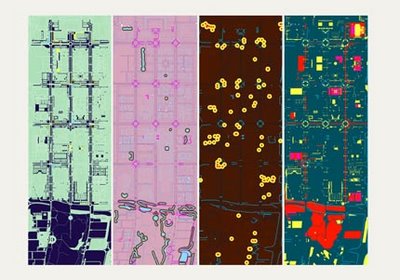
"My Psychoacoustic Maps of Milton Keynes explore ways of translating visual compositions into sound environments," Timon Botez of the London-based design firm CO-Designers writes. Botez is describing an event and exhibition he organized as part of last month's Architecture Week 2006, hosted in London.

"I have composed a series of maps based on colours I like," he continues. "The maps are visual environments, snapshots of a time of day, a mood or an experience in Milton Keynes. I have built a software that analyses the images and produces sound based on the colours. This forms the basis for the audio compositions that accompany the maps. The psychoacoustic maps are not functional, but they use the geometrical forms of the original city map as a basis for artistic expression."

Some of the audio tracks are quite mesmerizing; but if you don't like drumless electronic space or digitally glitched crackling background drones, then Botez's shudder-filled sci-fi audio-maps of Milton Keynes are probably not for you. But I particularly like the track called FridayEvening (or FridayEvenening, if its file name isn't a typo): here's the MP3. There's also Commute1 (MP3) and Sunday2 (MP3) – as well as five others, all available here.
At the very least, you can irritate dogs with them...
To some extent, though, Botez's project reminds me of two other urban-acoustic works. One is a piece called Surface Noise, by Scanner, which used one of London's old double-decker buses as an acoustic focus.
"Making a route determined by overlaying the sheet music from London Bridge Is Falling Down onto a map of London," Scanner writes, "I recorded the sounds and images at points where the notes fell on the cityscape. These co-ordinates provided the score for the piece and by using software that translated images into sound and original source recordings, I was able to mix the work live on each journey through a speaker system we installed throughout the bus, as it followed the original walk shuttling between Big Ben and St Paul’s Cathedral." The MP3s are downloadable from Scanner's site (scroll down), but certainly nothing to rush out for.
The other project I'm thinking of is an old CD-R called .murmer, released by Patrick McGinley. As McGinley himself explains, studiously avoiding upper-case letters, because only Fascists capitalize: "the source recordings for .murmer were all taken during my first six months as a resident of the city of london. hence they document my exploration and discovery of a new home, as well as of a new medium. i purchased my first recorder and microphone upon arrival here, and began exploring their possibilities alongside exploring the city. however, these sounds are not a portrait of a location; i made no attempt to map a geography. they are more personal. many originate from within my private space (the refrigerator and grill provided in a bedsit; the wind through an apartment window) and all are tied strongly to my personal movements (the air vent on my local bus, the heater in my place of work)." And so on.
Accordingly, McGinley's track ".errum" was made using the following urban sources: "air vent on a 73 bus, malfunctioning gas heater, feedback, escalator at pimlico tube station." Meanwhile, McGinley's photo diary –
– of which the above are several examples, apparently documents some of the more landscape-architectural references in his work; and his radio show – featuring "contextual and decontextualized sound activity" – can also be downloaded or streamed.
Finally, here are links to McGinley's own music; it's sparse stuff, but not bad if you simply want acoustic company. The track ".meurm" (MP3), for instance, was built entirely from the mechano-solipsistic moan of McGinley's refrigerator and gas grill (as mentioned above).
Soundtracks for architecture, indeed.
(Earlier: Urban sound walks and How to podcast a landscape).
No comments:
Post a Comment